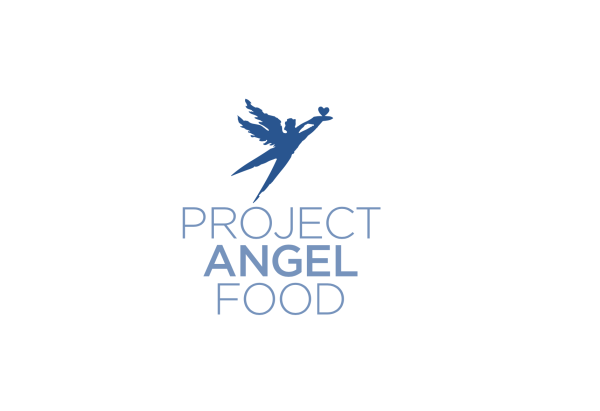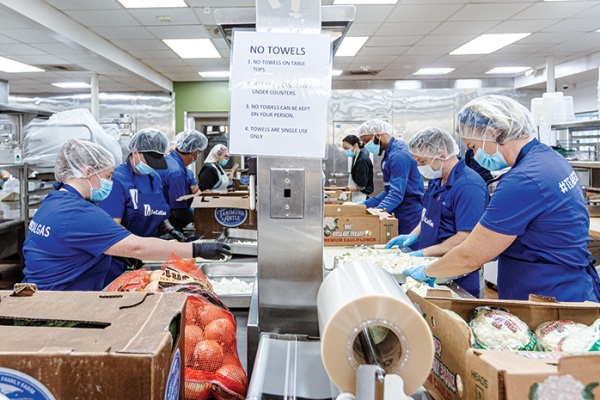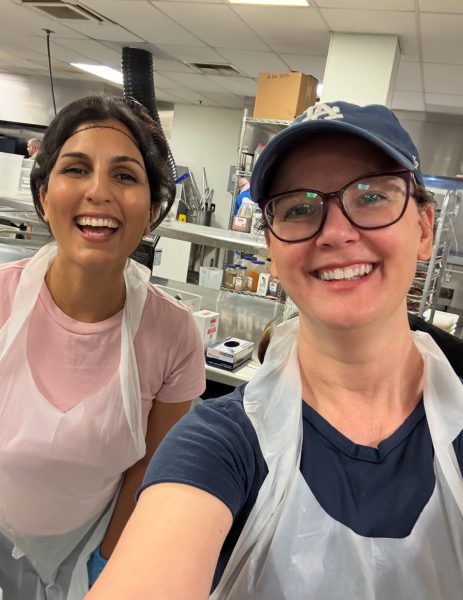Engaging your volunteers benefits an organization in the short-term and has long-lasting impacts as well. According to research by FIDELITY Charitable, volunteers donate an average of 10 times more money to charities compared to non-volunteers. Don’t let your organization miss the mark with your volunteers from the start: at orientation.
Volunteer orientations are an organization’s opportunity to draw a volunteer in, lead them to understand the power and potency of their work, and better understand the organization’s “why.” Story is the way to get them there.
 The Goodman Center recently volunteered at Project Angel Food and we were quickly captivated by the stories Volunteer Services Coordinator, Mark Cirillo, shared about the non-profit.
The Goodman Center recently volunteered at Project Angel Food and we were quickly captivated by the stories Volunteer Services Coordinator, Mark Cirillo, shared about the non-profit.
Project Angel Food prepares and delivers more than 1.5 million medically-tailored meals each year, free of charge, to individuals affected by life-threatening illnesses. Jasmine Elist, Operations Manager at The Goodman Center, Facetimed with Cirillo to talk communication style, the value of creative solutions, and the power of stories in changing minds.
The Goodman Center: During orientation, you shared the story of the history of Project Angel Food. Why was that an important story for you to share?
Mark Cirillo: I think it’s always important for people to know a little bit about the history and what we do and how we got here.
For my opening in orientation, I focus on the moments where [Project Angel Food] pivoted to serve L.A. County the way it needed us the most in that moment. Our start was serving all people with serious illnesses, but realized within the first few years that it was the HIV/AIDS community that needed us most. And that was the majority of our clients at the time so we actually narrowed our mission to serving only clients with HIV/AIDS for a few years, until science and medicine caught up.
That was a pivot.
And then as soon as people were doing better and living longer – which unfortunately took almost 10 years – we were then able to open up to serving all serious illnesses again.
And when the pandemic hit, our need doubled, and we had to expand drastically and as quickly as possible, which is why we’re in this temporary location now.
I think it’s pretty amazing that a non-profit can pivot to do what is needed most in the community, while staying true to the mission.
TGC: What communication style do you like to use?

MC: Light and fun. I just feel people hear things better that way – if it’s framed in a way that keeps them paying attention. And because people’s minds wander all the time, if you’re keeping them engaged, they absorb more and retain more.
I think comedy is a great way to get information to people without overwhelming them. People need the release of laughter at some point because even in our orientation, some of the statistics are horrifying. But you need them to know that we’re here. We’re doing the work. We’re here every single day. And the work is getting done. And we’re doing what we can in the greatest capacity possible to get it done.
TGC: During orientation, you offered the “why” behind certain rules. Why was including the “why” an important element of orientation for you?
MC: It’s so important. For me specifically, I have ADHD, so clarity is really important for me. And if it’s important for me, it’s probably important for a lot of other people – because then your head is not spinning or questioning and wondering why. Which may cause them to tune out and possibly miss the information that follows.
I don’t want people building resentment because of the frustration over not understanding. It’s all about keeping it as positive as possible while giving them the information they need.
TGC: What other big communications and storytelling moments do you use in your job?

Mark Cirillo, photo by ePhotoLA / Erin Leigh Photography
MC: We send weekly e-mails where we tell our over 4,000 active volunteers what special events are coming up that we need volunteers for. What are the needs in the kitchen this week. What are the different ways we need volunteers.
And that could be a really boring email. That could be like: we’re doing this, we’re doing this, we’re doing this.
And, so, I’m always trying to inject either a theme into the e-mail or something that ties into whatever else is happening that month. Something that makes it light, fun, and funny. Sometimes I just lean in so heavily to alliteration or something that just keeps your mind engaged. It’s always about keeping the engagement.
And I’m lucky because I grew up creative – focused in the arts and I think I am a natural storyteller. Not everybody has that. Not every nonprofit can find somebody where that’s natural to them. And I imagine that is a huge obstacle because it can be hard for people who aren’t creative to do that.

Jasmine Elist (left) and Kirsten Farrell volunteering at Project Angel Food
I think when [an organization] is hiring, especially a nonprofit where you’re always going to be involved with other departments, there’s always going to be an all-hands-on deck moment – it’s important to include creative people. It’s easier for [creative people] to switch back and forth, find creative solutions, and think outside the box. So, when people are hiring, they should realize the importance of that.
The feedback I get is so crazy positive from the e-mails and from the way I do engage with people that I’m like, “well, I guess it’s working.” And I know when a volunteer is coming in on a day when they don’t normally volunteer, or I’m meeting volunteers who have not volunteered since we moved to this new location and are responding to my emails, that it’s working and that makes me feel good.
TGC: What are some places organizations often forget to use stories that really matter, that you’ve noticed in other organizations?
MC: With almost any company, you find something out and wonder, “why is this not part of your story? This is going to impact people.”
It’s why I keep the detail in my orientation about how there are still clients where we may be their only human contact that day. If they are bedridden and if they don’t have a support system, they’re not seeing other humans. And now everybody knows what it was like in the pandemic to be alone, or to be trapped with people you didn’t want to be with. Everybody gets what that loneliness is like and what that can do to our mental health.
That’s where people connect – in the details.

TGC: Why do you think stories matter?
MC: I mean, history is stories and history matters. And stories are how everybody connects. Everybody has their own story. And I think – I don’t know why I’m getting emotional when I think about this – But… People not knowing people’s stories is why hate exists. The details and the similarities are how we connect – it’s how we realize we’re all in this together.
People that ignore history, the personal stories in history, and those details in history, that allows them to remain ignorant to what it is like for other people. And it makes it easier to not be kind. And to not care. Not being aware makes it easy not to care.
Stories change minds and open minds. The human race has always told stories.
As your organization seeks way to better engage volunteers, donors, and employees, consider Cirillo’s advice of infusing communication with lighthearted fun, with the “why” behind it all, and, of course, with the story that has the capacity to connect us all.
